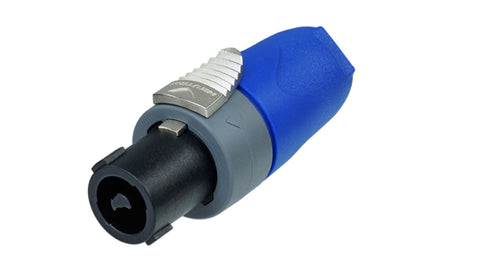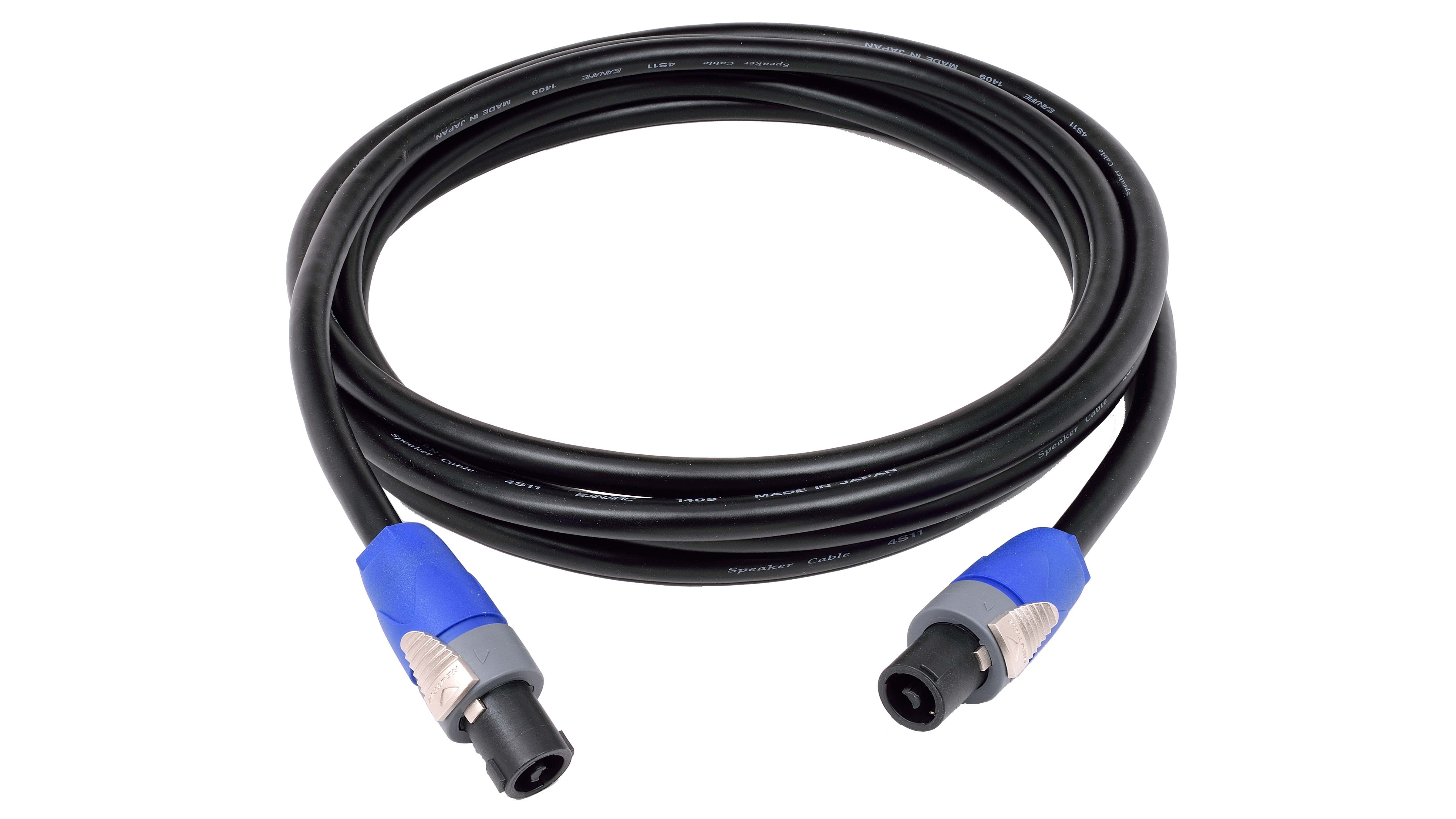Buy 2 components and get 4 free cables. Free shipping on all orders over $700.
Calculating the Performance of an Amplifier-Speaker Combination
by John Siau November 01, 2016
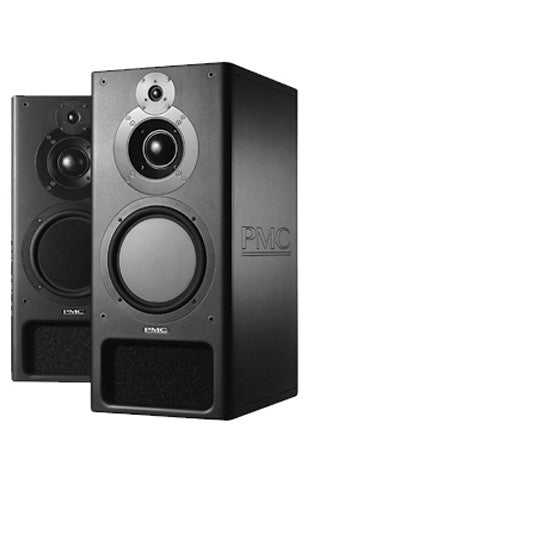
Calculating the Performance of an Amplifier-Speaker Combination - Example 1
In this application note we calculate the maximum output level and noise level produced by an amplifier/loudspeaker combination. Use this example for calculating the performance of your system.
Our Test System - AHB2 Driving PMC IB2S Studio Monitors
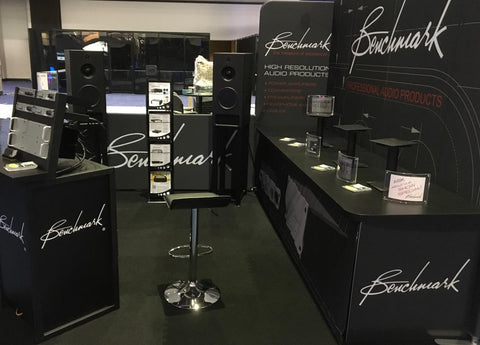
At the 141st AES conference we demonstrated two Benchmark AHB2 monoblock power amplifiers driving a pair of 4-Ohm PMC IB2S studio monitors.
In bridged mono, the AHB2 can deliver over 518 watts into each of these 4-Ohm speakers. This is a perfect match to PMC's 500 watt recommendation. The AHB2 easily provides the power, the output current, and the damping required by these low-impedance speakers. The impedance and phase curves are similar to the older IB2i model (shown in the graph below).
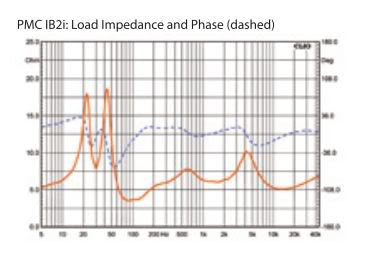
AHB2 THD+N and Power into 4-Ohms, Bridged Mono
The following plot from an Audio Precision audio analyzer shows the output of the AHB2 driving a 4-ohm load in the bridged mono (single channel) mode. The magenta-colored heavy line shows the power output in watts (W), which can be read off the left-hand vertical axis. The narrower red line shows the total harmonic distortion plus noise (THD+N), which can be read in percent from the right vertical axis. The horizontal axis is the input level to the amplifier. The input level is swept over a 20 dB range which is equivalent to a 100:1 power range (producing a 6 W to 600 W output power sweep from the AHB2).
Note that the output of the AHB2 reaches 518 watts (W) before the THD+N, which remained below 0.001% begins rising. The THD+N is only 0.00083% at 518 W! At the upper right-hand corner of the plot we can see that the AHB2 delivers about 590 W at 1% THD+N. This plot demonstrates the high level of clean power that is available from the AHB2 when driving 4-ohms in bridged mono mode.
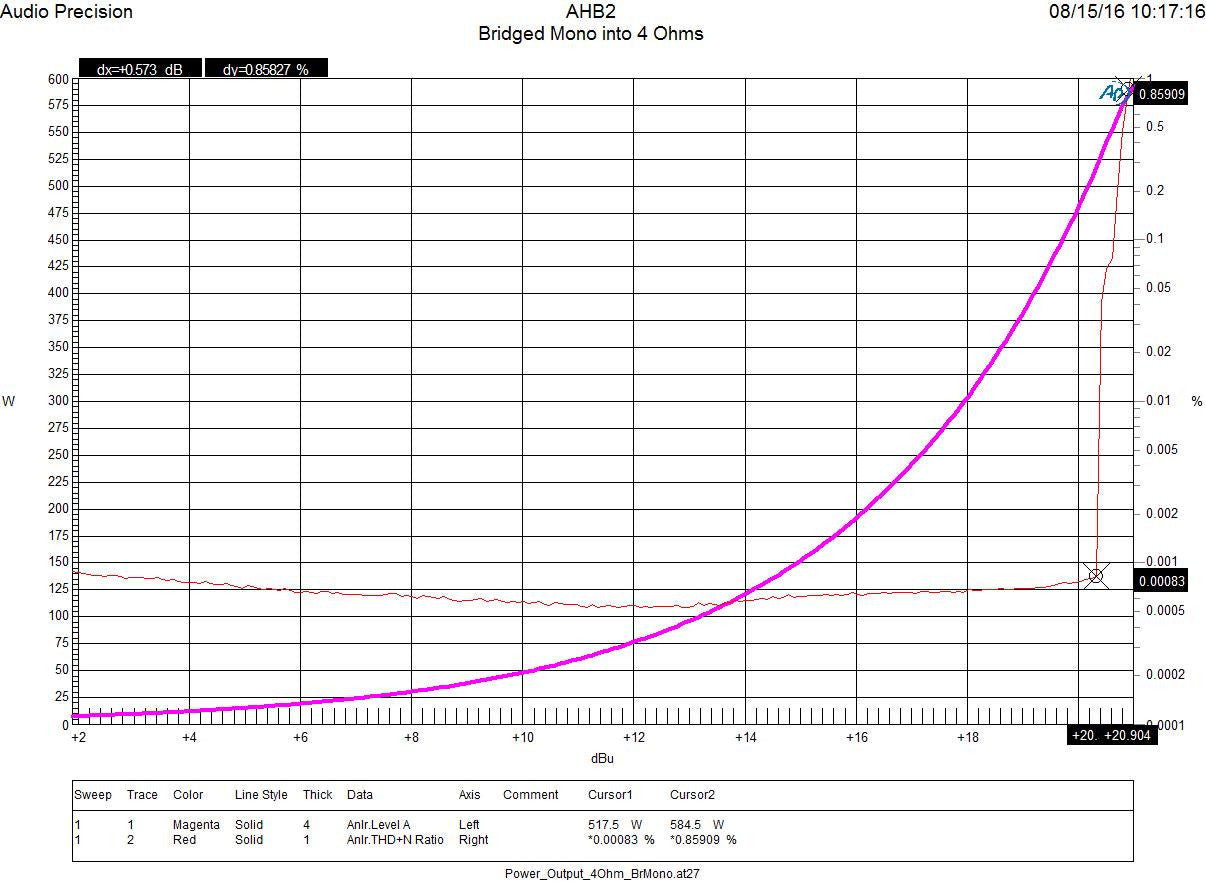

Maximum Sound Pressure Level
The PCM IB2S monitors have a power sensitivity of 89 dB, 1 W @ 1 m. At 4 ohms, this is equivalent to a voltage sensitivity of 92 dB, 2.83 V @ 1 m (add 3 dB for 4-ohm speakers when doing this conversion). From the voltage sensitivity, we can calculate the maximum sound pressure level when the monitors are driven from AHB2 amplifiers running in mono mode.
With a 4-Ohm load, the AHB2 monoblocks will deliver 518 Watts. The maximum unclipped output voltage is 45.5 Vrms (64.4 V peak). This is 24.1 dB higher than 2.83 Vrms (20*log(45.5/2.83)=24.1 dB). If we add 24.1 dB to the voltage sensitivity of 92 dB we can calculate that the maximum sound pressure level should be about 116 dB at 1 meter from each monitor. This calculation ignores the slight losses that would be produced by power compression due to voice coil heating. Given the size of the voice coils in the IB2S drivers, power compression should be minimal in this example.
At 116 dB SPL, this amplifier/monitor combination will have no trouble filling a good sized control room. The IB2SE hifi version has identical performance and should be very capable in just about any home environment.
Amplifier Noise is Well Below Audibility - A Quick Estimation
In bridged mono the AHB2 has a 135 dB A-weighted signal to noise ratio. This means that the output noise will be about 135 dB lower than the maximum sound pressure level produced by the monitors. If we subtract the SNR from the peak SPL determined above, we can calculate that the amplifier noise will be reproduced at a level that is 19 dB below the threshold of normal hearing (116-135=-19 dB SPL).
Verification - Use Your Ears
In our test setup we confirmed that the AHB2 - IB2S combination is dead quiet at a point-blank distance. The industry-leading 135 dB SNR of the AHB2 really pays off when driving medium and high-sensitivity loudspeakers. With a 135 dB SNR, the AHB2 is 17 to 30 dB quieter than the competition!
If you do the math, it is easy to see that competing amplifiers will produce audible noise when driving 92 dB speakers such as the IB2S. Eliminating low-level hiss and buzz from the monitor chain can help resolve low-level details in the mix. For best results, the studio monitor chain should be dead quiet.
Accurate Method of Calculating Noise
If the amplifier output noise is specified, we can use this to make a more accurate calculation noise produced by the amplifier/speaker combination.
The A-weighted output noise of the AHB2 is 9.8 uV rms when running in mono mode. This is -109 dB relative to 2.83 V rms (20*Log(0.0000098/2.83). Add -109 dB to the voltage sensitivity of your loudspeakers, and you can accurately calculate the acoustic noise produced by the amplifier/speaker system at 1 m. This method is slightly more accurate than subtracting the SNR from the maximum output level because it is not affected by the speaker impedance.
If we rerun the calculations for the IB2S, using this improved method, we will find that the amplifier noise is actually reproduced at - 17 dB SPL (92 dB - 109 dB = - 17 dB). The 2 dB difference is due to the fact that 4-ohm bridged mono loading on the amplifier reduces the clip point of the amplifier by about 1.9 dB relative to 8-Ohm bridged mono loading. The SNR is measured with an 8-Ohm load. The noise does not change with loading, but the maximum unclipped output level changes by 1.9 dB.
This 1.9-dB reduction is very small and it demonstrates the value of the regulated power supplies in the AHB2. In contrast, conventional power amplifiers traditionally have unregulated power supplies. The output of most amplifiers would be reduced by much more than 1.9 dB when driving 4 Ohms in a bridged mono configuration.
Clarity and Accuracy
I am very impressed with the clarity and accuracy of these outstanding professional monitors. The Benchmark AHB2 and PMC IB2S are an absolutely killer combination!
Notice the cutaway frame on the midrange driver. The close proximity of the HF and MF drivers helps to keep the imaging tight and well defined. This configuration provides excellent imaging at a much closer listening distance than the cabinet size would suggest. The vertical alignment of the drivers is also an important contributor to the tight imaging provided by these monitors. This combination of vertical alignment and close driver spacing gives these monitors the ability to image well in nearfield to midfield applications.
Center mixed cymbals, brushes and bells are accurately placed in the phantom center image without a trace of high frequencies locating to the drivers themselves. This is an indication that the phase and amplitude responses of the HF drivers were very well-matched between the left and right monitors.
Bass Extension
The 25 Hz bass extension is impressive when playing tracks with deep bass. This is especially true when the monitors are driven by a Benchmark DAC3 to AHB2 signal chain. The DAC3 and AHB2 both have a frequency response that extends down to 0.1 Hz. This 0.1 Hz extension keeps the bass clean while eliminating low-frequency group delays that would cause the bass to arrive late.
Strategic Choice of Crossover Frequencies
The 380 Hz and 3.8 kHz crossover frequencies of the IB2S are largely outside of the vocal range. This means that most of the male and female vocal range is delivered by the midrange driver. This strategic choice of crossover frequencies keeps the vocals exceptionally clean, natural, and well focused.
Caution - Keep an Eye on the SPL
One word of caution: This combination is so clean that you will need to keep an eye on the sound pressure level. They effortlessly reach high sound pressure levels and therefore are much louder than they sound. Keep an SPL meter nearby until you get accustomed to the clarity of this system.
The Test System
Our test system included a Benchmark DAC2 HGC driving two AHB2 power amplifiers. Each AHB2 was running as a monoblock. The combined DAC2 HGC - AHB2 - IB2s signal chain is dead quiet.
The AHB2 amplifiers have a mono switch and a dedicated NL4/NL2 SpeakON output to support the mono mode of operation. On each amplifier, this mono output was connected to a PMC IB2S using Benchmark Studio&Stage™ NL2 SpeakON to locking banana cables. These cables use a star-quad construction to minimize magnetic emissions and losses.
The IB2S monitors have internal passive crossovers and buss bars that strap the inputs so that all three divers can be run from a single amplifier. This is the configuration that we recommend when driving them with the Benchmark AHB2. Locking banana plugs work well with the binding posts on the IB2S.
Avoid Spade-Lug Connections
We highly recommend using SpeakON cables rather than cables with spade lugs. In our tests, we found that SpeakON connectors consistently made better electrical connections than spade lugs. Locking banana plugs are a good choice when Speakon connectors are not available. The AHB2 power amplifier is so clean that we can easily measure the distortion caused by spade lug connections that are not as clean and tight as they need to be. Spade lugs tend to loosen when cables are moved. When possible, use the SpeakON outputs on the AHB2, and use locking banana plugs to connect to speakers that are not equipped with SpeakON connectors.
Benchmark Studio&Stage(TM) Speaker Cables
Benchmark Studio&Stage™ Speaker Cables were used in this test.
Studio and hi-fi Versions
The PMC IB2S is also available in the IB2SE hi-fi version. Both have identical performance but the IB2SE is available in finishes that will blend into a home environment. The hifi version also features a more attractive stand.
PMC IB2SE - Passive Hi-Fi Loudspeaker

PMC IB2S - Passive Studio Monitor

Edited 5/19/2017 - Added text to explain the THD+N and Power plot. Text contributed by Jeff Switzer. Thanks for the feedback Jeff! - John Siau
Also in Audio Application Notes

Audiophile Snake Oil
by John Siau April 05, 2024
The Audiophile Wild West
Audiophiles live in the wild west. $495 will buy an "audiophile fuse" to replace the $1 generic fuse that came in your audio amplifier. $10,000 will buy a set of "audiophile speaker cables" to replace the $20 wires you purchased at the local hardware store. We are told that these $10,000 cables can be improved if we add a set of $300 "cable elevators" to dampen vibrations. You didn't even know that you needed elevators! And let's not forget to budget at least $200 for each of the "isolation platforms" we will need under our electronic components. Furthermore, it seems that any so-called "audiophile power cord" that costs less than $100, does not belong in a high-end system. And, if cost is no object, there are premium versions of each that can be purchased by the most discerning customers. A top-of-the line power cord could run $5000. One magazine claims that "the majority of listeners were able to hear the difference between a $5 power cable and a $5,000 power cord". Can you hear the difference? If not, are you really an audiophile?

Making Sound with Plasma - Hill Plasmatronics Tweeter
by John Siau June 06, 2023
At the 2023 AXPONA show in Chicago, I had the opportunity to see and hear the Hill Plasmatronics tweeter. I also had the great pleasure of meeting Dr. Alan Hill, the physicist who invented this unique device.
The plasma driver has no moving parts and no diaphragm. Sound is emitted directly from the thermal expansion and contraction of an electrically sustained plasma. The plasma is generated within a stream of helium gas. In the demonstration, there was a large helium tank on the floor with a sufficient supply for several hours of listening.

While a tank of helium, tubing, high voltage power supplies, and the smell of smoke may not be appropriate for every living room, this was absolutely the best thing I experienced at the show!
- John Siau

Audio Calculators
by John Siau June 04, 2023
We have added an "Audio Calculators" section to our webpage. Click "Calculators" on the top menu to see more like these:



